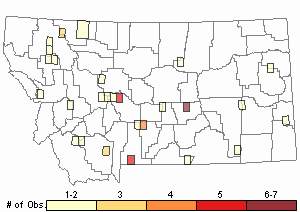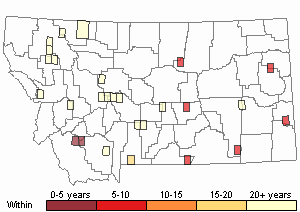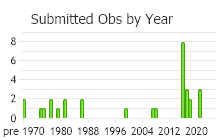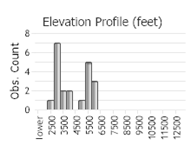View in other NatureServe Network Field Guides
NatureServe
Montana
Utah
Wyoming
Idaho
Wisconsin
British Columbia
South Carolina
Yukon
California
New York
Rooftop Pseudoleskeella Moss - Pseudoleskeella tectorum
General Description
Plants: Pleurocarpous, growing in slender, widely-spreading mats, deeply olivaceous or seldom green with yellow tones. Stems hugging the substrate, freely branched, the branches distant and appressed; paraphyllia not present; rhizoids borne in groups on leaves near the leaf attachment (FNA 2014).
Leaves: Hugging the stem to upright when dry, spreading to about 45 degrees when damp, 0.4-1.2 mm in length, about twice as long as wide or a little less, cupped, not pleated, egg-shaped, the base spreading, narrowing above to an acumen, the acumen occasionally curved in sickle-like fashion and without a hair-point; leaf edges flat or seldom curved back and downward below; costa typically but not always double, occasionally absent, extending less than halfway up the leaf. Branch leaves smaller than stem leaves, egg-shaped to nearly round. Leaves of stoloniferous stems widely egg-shaped to nearly round (FNA 2014).
Leaf Cells: Stem leaves with lower laminal cells isodiametric to twice as long as wide; medial cells with length similar to width or to 3 times longer, smooth, the walls of medium thickness; alar cells square to short and oblong, only slightly distinct from adjacent cells. Branch leaf medial cells typically not as long as those of the stem leaf (FNA 2014).
Phenology
Fruit ripens in summer (FNA 2014).
Range Comments
North American Range
Canada: NT and NU, BC to SK, ON, QC and NL; USA: AK and the western half extending to ND s to KS., also MN and MI (FNA 2014). Known in Montana from Carter, Cascade, Fallon, Fergus, Flathead, Glacier, Golden Valley, Granite, Lake, Lewis and Clark, Madison, Meagher, Missoula, Park, Rosebud, and Sweet Grass Counties (Elliott and Pipp 2016).
Observations in Montana Natural Heritage Program Database
Number of Observations: 54
(Click on the following maps and charts to see full sized version)
Map Help and Descriptions
Relative Density

Recency



 (Observations spanning multiple months or years are excluded from time charts)
(Observations spanning multiple months or years are excluded from time charts)
Habitat
In shaded areas on basic stone, wood, and bottoms of trees, the mats sometimes fully adorning vertical faces of protected boulders and hanging over bluff edges. Ranging from lowlands to alpine elevations (FNA 2014).
Reproductive Characteristics
Dioicous. Seta 1-2 mm tall, russet. Capsule slanted, 1.5-3 mm in length; exostome teeth lance-shaped and sometimes very slender, with delicate, horizontal lines; endostome processes slender; cilia present (FNA 2014).
Stewardship Responsibility
References
- Literature Cited AboveLegend:
 View Online Publication
View Online Publication Elliott, J.C. and A.K. Pipp. 2018. A Checklist of Montana Mosses (1880-2018). Updated 3 January, 2020. Montana Natural Heritage Program, Helena, Montana. 73 pp.
Elliott, J.C. and A.K. Pipp. 2018. A Checklist of Montana Mosses (1880-2018). Updated 3 January, 2020. Montana Natural Heritage Program, Helena, Montana. 73 pp. Flora of North America Editorial Committee, eds. 2014. Flora of North America North of Mexico. Volume 28. Bryophytes: Mosses, Part 2. Oxford University Press, Inc., NY. xxi + 702 pp.
Flora of North America Editorial Committee, eds. 2014. Flora of North America North of Mexico. Volume 28. Bryophytes: Mosses, Part 2. Oxford University Press, Inc., NY. xxi + 702 pp.
- Additional ReferencesLegend:
 View Online Publication
View Online Publication
Do you know of a citation we're missing? Elliot, J. C. 1993. Second checklist of Montana mosses. Unpublished report. U.S. Forest Service, Region 1. Missoula, MT. 45 pp.
Elliot, J. C. 1993. Second checklist of Montana mosses. Unpublished report. U.S. Forest Service, Region 1. Missoula, MT. 45 pp. Lawton, E. 1971. Keys for the Identification of the Mosses on the Pacific Northwest. Reprinted from 'Moss Flora of the Pacific Northwest'. Published as Supplement No. 2 of the Journal of the Hattori Botanical Laboratory. Nichinan, Miyazaki, Japan. 66 pp.
Lawton, E. 1971. Keys for the Identification of the Mosses on the Pacific Northwest. Reprinted from 'Moss Flora of the Pacific Northwest'. Published as Supplement No. 2 of the Journal of the Hattori Botanical Laboratory. Nichinan, Miyazaki, Japan. 66 pp. Lawton, E. 1971. Moss Flora of the Pacific Northwest. Hattori Botanical Laboratory. Japan: Yamabuki-cho, Shinjuku-ku, Tokyo. 362 pages plus appendices.
Lawton, E. 1971. Moss Flora of the Pacific Northwest. Hattori Botanical Laboratory. Japan: Yamabuki-cho, Shinjuku-ku, Tokyo. 362 pages plus appendices. Malcolm, B., N. Malcolm, J. Shevock, and D. Norris. 2009. California Mosses. Nelson, New Zealand: Micro-Optics Press. 430 pp.
Malcolm, B., N. Malcolm, J. Shevock, and D. Norris. 2009. California Mosses. Nelson, New Zealand: Micro-Optics Press. 430 pp.
- Web Search Engines for Articles on "Rooftop Pseudoleskeella Moss"





